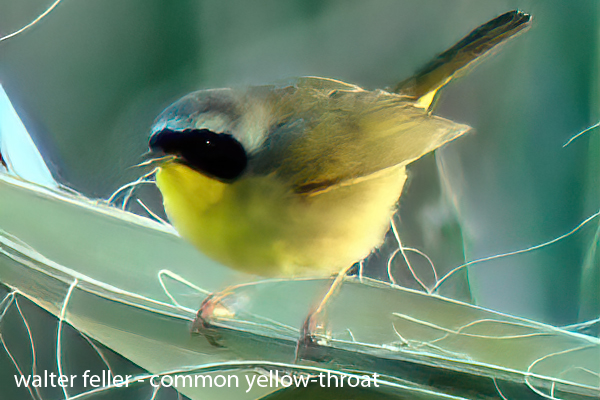Common yellowthroat
Geothlypis trichasFamily: Parulidae (New World Warblers)

Identification:
Small, energetic warbler.Male: Olive-green back, bright yellow throat and breast, bold black mask with white border.
Female: Duller olive above, pale below with yellow on the throat and chest; no mask.
Size:
Length: 4.3 to 5.1 inchesWingspan: 5.9 to 7.5 inches
Voice:
Song is a repeated "witchety-witchety-witchety," often heard from dense cover.Habitat:
Prefers wetlands, marshes, and dense brush near water. Often seen in cattails, reeds, and low shrubs.Range:
Breeds across most of North America. Winters in the southern U.S., Mexico, and Central America.Diet:
Eats insects and spiders. Forages low in vegetation, moving quickly and often staying hidden.Behavior:
Usually stays low in thick growth. Males are more vocal during breeding season. Flits actively through underbrush.Note:
The males black face mask has earned the species the nickname Masked Bandit.Common Yellowthroat Mojave Desert Locations
1. Mojave River Found near Victorville, Helendale, and Afton Canyon. Dense vegetation along the river provides excellent habitat.2. Big Morongo Canyon Preserve Near Morongo Valley. A year-round water source with marshes and thick riparian growth. Regular sightings.
3. China Ranch Near Tecopa. Lush growth along the Amargosa River makes this an ideal spot, especially during migration.
4. Amargosa Canyon and Shoshone Dense willow and mesquite habitat along the Amargosa River supports yellowthroats.
5. Lake Mead National Recreation Area Found around marshy coves and wash outlets with cattails and reeds.
6. Desert Studies Center (Soda Springs) Near Baker in the Mojave National Preserve. Spring-fed wetlands attract yellowthroats in migration and breeding season.
7. Piute Ponds Located on Edwards Air Force Base near Lancaster. Seasonal wetland habitat; access requires permission.
8. Kelso Dunes area Mojave National Preserve. May be found near springs or dense vegetation along washes, mainly during migration.
These locations provide the cover and water this species needs. Most sightings occur in spring and fall, but some areas support breeding populations.